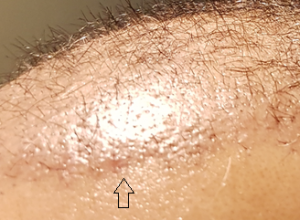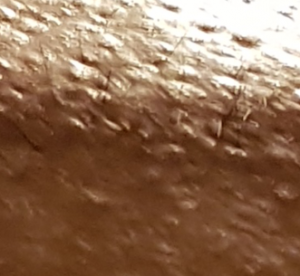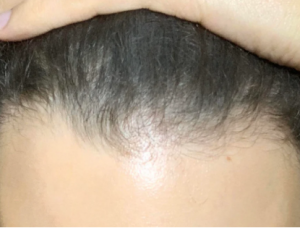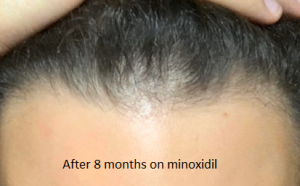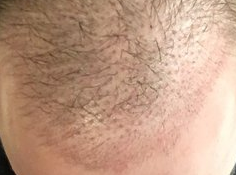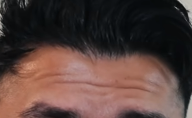I’m sure my hair loss is mpb but it’s going so fast, like a few days ago I could comb my hair to hide receding hairline now I can’t. All the hair falling is long healthy looking hair, not small or thin. Can extreme stress be causing mor than normal hair loss? If I can get back to normal state can it be reversed partially at least? My father also have hair loss but his started at 35 and is not too bad, at 55 he is Norwood 5. I’m 28 and Norwood 3 at the moment. I’m anxious since I was 14. Lots of stress at 22-23 when my hair started to fall but wasn’t noticeable until 25-26 Then it went too fast. My stress level also progressed with time I’m in 24/7 extreme stress now.
I have these bumps on my recipient area. I had the surgery 6 weeks ago and these bumps seem to stick around. I asked my doctor about it and he said not to worry, they would go away. What do you think?
This is classic cobblestonning, something we used to see a great deal when the grafts were larger. These grafts were not placed flush with the skin so they healed elevated with this cobbling just like a cobble stoned street of the old days. This may or many not go away. There is nothing you can do about this. I never allow my grafts to be placed above the surface of the skin so I never get cobbling. The arrow on the picture on the left, shows elevation of the grafts from the flat forehead, a classic cobbling effect.
from the reports, the answer is yes! I suspect that you would have had to have experienced sexual side effects for some time for this to happen to you. There is still doubt in the medical community that this syndrome may not be real. I have no opinion one way or the other
We have reported on this before many times, see here: https://baldingblog.com/?s=balding+heart+disease
Now another recent article expands upon these reports see here: https://www.cidjournal.com/article/S0738-081X(17)30166-9/fulltext#%20
I’ve been a lurker for awhile and have learned a lot of helpful info from this community. I’ve been dealing with baldness since around high school, when I noticed my hairline receding. I experimented with Rogaine and Propecia and was able to keep density and restore my hairline somewhat, but out of fear of impotence and such I retired the meds and have my hopes on one day getting a hair transplant.
Now more than 10 years later, my hairloss has progressed and I’ve been forced to buzz my head constantly with more hairline recession and thinning at the crown. I’m not sure when I’ll be ready to make the hair transplant jump, but have been recently looking more into SMP, since I already keep a buzzcut.
My question is, if I were to go ahead and get SMP done, while still hoping to get a hair transplant in the future as hair thinning continues, will the SMP procedure complicate a future transplant or ruin candidacy? Is it worth to spend money on both? Ideally would love to have a head full of hair again.
You can do Scalp Micropigmentation (SMP) and then down the road, if you need a hair transplant you can still do it. Be sure that you find a medical group that does both so that they have experience with it like we do. Your strategy sounds good to me. Look at our website: https://scalpmicropigmentation.com/
This is an extremely complete assessment of the long term use of this controversial drug. The writer concludes that adding minoxidil and microneedling will increase the benefit and I agree with that conclusion.
Information on Finasteride Dosage and Long term Efficiency
Hi everyone I previously made a post about the ultimate hair loss protocol, the post consisted of the best treatments of hair loss and mainly debunking some finasteride risks. However today I will be discussing finasteride importance in people’s protocol, dosages, and long term efficiency. Before I get into the niddy griddy lets get one quick point out of the way
- For the vast majority of people, testosterone levels in the normal range (400-1100ng/dl) will have very minimal effect on hair loss, and there have been some theories and studies going around that having optimal T levels in the natural range, Optimal T/DHT ratios, and nonexcessive body fat, can help hair loss. Most people PRONE TO HAIR LOSS will probably lose hair quicker when being high body fat and low t levels, then compared to if they were a lower body fat (under 18%), and high natural range T levels. Now don’t misinterpret what I am saying, thinking becoming healthier will cure hair loss, or help it in an extreme way. Nope, there is gonna be a guy out there 300 pounds eating burgers all day and will have a NW 1 at 50, it’s genetics my friends, other then a few rare deficiency and hair thinning from hyperthyroid, almost all your hair loss is from your genetic makeup, specifically, your scalp sensitivity to DHT. Dereck from MPMD did an experiment before bringing his t levels to 2000 ng/dl and using dutasteride, he reported experiencing hair loss, ( didn’t, seem to be extremely noticeable), however, all his experiment really proved was that testosterone above the natural range can cause hair loss, but most of us will not be having our T levels that high.
Now let’s begin with finasteride.
As you can see above is the 5 year study of finasteride 1mg a day consisting of 4 different groups. Some interesting things to notice
- The placebo group demonstrated an increased rate of hair loss from year to year, playing into the theory that our androgen sensitivity goes up as we get older, or something else that is causing an increased rate of hair loss each year.
- The validity of the statement that starting finasteride earlier is clearly shown above, showing that starting a finasteride year later, did not catch up to the group that was finasteride the entire time. BASICALLY START FIN NOW THEN LATER.
- The group that went off finasteride after one year, went down to the same spot as the placebo group after one year. However, after going back on finasteride, the group reached to almost the same position as the group that was on finasteride for the entire study. So it seems the reports that taking a break from finasteride after using it for seemingly a year or above, will not hurt your gains to a noticeable degree and possibly changing some factors to your scalp which are the slightly permanent or delayed benefit after stopping use of finasteride.
Now based on the people on finasteride for all 5 years, we can use simple math to predict long term efficiency of finasteride, which can also be back up with a study that I will demonstrate after.
So we will take the highest finasteride hair count, which is after one year on average. Based on multiple studies I took the average hair count after one year to be (80) on 1mg per day, also using this number to be conservative. We know the hair count change from baseline after 5 years was (38), So using these two points including the years we can create a formula to calculate the efficiency of finasteride. Again note this is just an estimate
(1,80), (5,38)
y= -10.5(x) + 90.5 *x is the year on finasteride and calculation result is hair count, estimate not exact
So based on this formula using the data above after 10 years we can estimate that the average man on only finasteride will be -14.5 below the baseline. Again you may be higher, while some are lower, that is just the average. Now compare this to the placebo group which the information found online the average loss after a year from baseline is -15 (imagine 10 years on finasteride is equivalent to one-year placebo for the average man….crazy), now after 5 years the placebo group was -239 below baseline, so again let’s do some calculations.
(1,-15),(5,-239)
y= -56(x) + 41
That means after 10 years of no finasteride the average hair count is a staggering -519 below the baseline.
The group starting finasteride after one year of being in the placebo group.
(1,50), (5,4)
y= -11.5(x) + 61.5
For this group after 10 years we have a hair count of – 53.5, this is equivalent to about two years without finasteride in the placebo group.
Again above is considered a worst-case scenario since two studies have been published on finasteride, with the duration of finasteride use being 10 years, demonstrating that finasteride either increased or stabilized hair count in 86-91% of patients. So the calculation above should really be giving you the worst case result, which is still great, showing finasteride being great for stabilizing hair loss for many years. Also consider this is just finasteride, no minoxidil, dermarolling, alfatradiol, RU, and CB.
Now for finasteride dosage.
Fuck the dosage curve. yes, the one I am showing you below,
This graph tells me absolutely nothing, just how much DHT is being inhibited, great, but what you and I care about is hair growth, stabilization, cost, and side effect free profile.
Based on this graph it should make no sense why lower dosages work for some people, in terms of side effects being alleviated.
Based on hair count after one year
1mg inhibits exactly the same amount of DHT as 5 mg yet 1 mg is 80-90% (Based on a couple of studies). 5mg is shown to have a higher side effect profile compared to 1 mg, even though they inhibit the same amount of DHT. 0.2 mg daily is 80% as effective a 1 mg, yet it only inhibits 3-7% less DHT. So again DHT levels do not seem to matter in terms of side effects and efficiency, or they are not entirely correlated. So many people on the site are wondering what the most cost-effective dose as well as side effect free profile. Well for starters we want to at least take finasteride on a regular basis meaning every day, every other day, or 3 x a week. So assuming 1 mg is the gold standard lets calculate using the info of 0.2 vs 1 mg hair count. We will use the total weekly amount of each so 7 mg a week vs 1.4 mg per week.
(1.4,61), (7,77)
y= 2.86(x) + 57 (x being the weekly dosage)
So if you take 1 mg (3x a week) that would mean your hair count would be 65, then there is 1.25mg 3 times a week will give you a hair count is 68. So you get the point, there are diminishing terms. In technical-scientific terms no 3 x 1mg a week is not as good a 1mg daily, however the difference is minimal, and if lowering your dosage allows you to take finasteride side effect free, which seems to be dose-dependent, please lower your dosage, knowing that finasteride is used for stabilization and that using things like minoxidil and derma rolling should be used for major hair regrowth.
Hope you enjoyed the post. Have a good day
The actual text with good graphics can be found here: https://www.reddit.com/r/tressless/comments/hyv2fg/information_on_finasteride_dosage_and_long_term/
Take a look at this photo in the post here: https://baldingblog.com/what-does-dupa-diffuse-unpatterned-alpopecia-look-like/ . This man has DUPA and as you can see there is extensive miniaturization in the zoomed-in photo. I need to see such a photo of you to give you an answer to your question.
when i microneedle i achieve redness all over the scalp, but within the hour the redness goes away and by the morning it’s completely gone and i feel no pain at all. am i doing it wrong? is there no inflammation?
Some people have Histamine positive skin which turns red easily. If you scratch your forehead with your finger nail and it turns red in a few minutes, then you have Histamine positive skin. It just takes longer to lose the red color. Microneedling is becoming more and more popular to bring back the hair from the micro-wounds it creates. It does work on some people
Has your relationship with alcohol changed since being on fin? Personally I used to drink a lot and now I kind of dislike drinking and only drink once in a while. Not sure if this is a rare reaction or even caused by fin.
Drinking with finasteride is not a problem
Back when I had hair girls used to flirt with me and tell me how good looking I was. Now women see the bald head and don’t give me a second glance. It’s as if their minds are seeing my head and picturing their children with me coming out bald with a Norwood 6. Before I didn’t have to say more than 3 words to get a woman interested in me, but it takes so much effort now.
Society has always discriminated against men with balding. It goes back over 2000 years when tuberculosis was running rampant producing balding men because they were sickly. That set up a connection between balding on one side with a sickly man, and a healthy vibrant hairy man on the other side. So the norm has been propelled for centuries and it is somehow ingrained in our culture. Men wore wigs or hats to hide their balding so women wouldn’t be able to tell. Met wore top hats in the late 1800 and early 1900s. Today we wear baseball caps. We are still victims of this culturally, unfortunately.
Be patient and everything will turn out ok. Some people, a rare few, keep their redness for up to a year. It always happens in redheads, blondes, and fair haired people when it happens. Sometimes the use of topical steroids can address the redness. When all of the hair grows out, the redness will barely show,
A reader on Reddit answered it this way. Not a bad attempt but I can’t endorse it all. I see incidence reports that run from 1% to .1%. Here is the reddit response
0,02 % of people based on clinical studies made from pfs foundation….
This is 1 of 5000 people in lifetime during using
Of which medium time to get normal is 3 years…
3 years without medication, like trt proviron ecc
You literally have 50 more chances to die on a car accident
You have 10 more chances to die walking by street
And you have 2 times more chance to die choked on food…
So in reality is pretty safe like a drug, and to be even safer just do a blood work controlling your hormone panel….
Than after this every 6 months do hormone profile to check if everything is in range and you are good to go….
The majority of pfs, comes from hormone that was bad at the start of medication and during the medication they hormones get messed up (which can be seen on blood work) and they continue because they didnt have sides and then when they stop they body overact and pfs comes….
Other than that you can have once in a year a stop of one month, to wash the chemicals in your body, and restart again….
With all this literally the chances to get something its almost 0.
And in many reputablr clinical studies, after discontinuation of the drug, more people experienced persistence of sides on placebo grouo than the finesteride group….
Which doesnt mean that pfs fin sides doesnt exist, but many people nocebo themselfs to think that they have something which they dont, and many people have some problems in they body outside the drug
1 in 5000 is a real pfs, so if there is like 1milion consumers, we can expect that we have 200 pfs patients with it…
This number is so low, that doctors cant know how to take out this people from that, and this is why having blood work pre fin and during fin so that an endrychonologist will know how to bring you back in normal state if they have something to work with….

